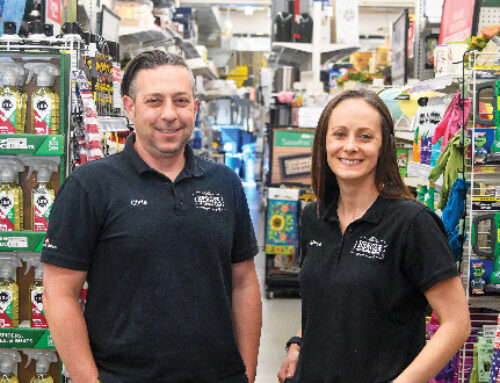Impulse purchases provide opportunities for add-on sales throughout the store and at the checkout. Stocking items adorned with your store’s branding, small trinkets and food items can be enticing to customers perusing your shelves or waiting in line to check out.
Patrick Olson, owner of Maumee Paint & Supply in Fort Wayne, Indiana, takes a traditional approach to impulse purchases but adds his own flair to his product offerings. Discover three ways he makes impulse purchases work for his operation.
Merchandising on the Move
When Olson introduces a new impulse item, he moves it around the store for the first few months to see where it generates the most sales. Since Olson’s store is roughly only 4,500 square feet, he is strategic about the inventory he brings into the store.
During certain times of the year, he places seasonal items on endcaps instead of traditional impulse items.
“In the months leading up to summer, a lot of our endcaps are stocked with swimming pool paint,” Olson says. “It may not be considered a typical impulse item, but pool paint is something we push a lot in the summer and by having it on an endcap, it gains the attention of customers who need this product.”
Olson says when a product on an endcap is in the customers’ line of sight, people will react quicker if it’s one of the first products they see when they walk into the store.
Another way Olson merchandises his impulse products is by stocking them near similar items. Near his lighting fixtures, Olson stocks handheld flashlights, a small accessory that is similar to the surrounding products.
In his spray equipment section and up at the checkout counter, Olson stocks various spray tips, partnered with bold signage with the price taking precedence. When he prices his spray tips, he isn’t trying to make as much of a profit as he does with other products.
“I’m very aware of our competition’s price on spray tips and purposely have our price stand out,” Olson says. “I purposely sell them cheaper to make them an impulse item.”
Consider Custom
When considering what should be in your impulse category, think about small, fun and low-cost items. Customers are more likely to make an impulse purchase if the item is well-priced, easy to find or something that is unique.
One item that performs well for Olson is custom paintbrushes with his store’s name printed on the handle.
“We have this 1-inch brush at our checkout counter with our name and phone number on it, and we’ve sold countless number of them since I bought the store,” Olson says. “I set them right by our credit card processor so people see them as they are checking out.”
By placing his custom brushes where customers wait as they check out, it’s one of the many items they see and have a small amount of time to decide on the purchase.
“A lot of customers don’t make eye contact with our sales associates,” he says. “Hopefully, we can catch their eye with products instead as they are checking out.”
Don’t Always Say Yes to Impulse Products
Being a store owner and traveling to markets throughout the year, Olson says he’s constantly approached by companies and sales reps looking to get their impulse products into his store. One of his biggest tips he’s learned in his few years of owning his store is to not jump at every opportunity presented.
Rather, Olson takes a calculated approach to bringing in an impulse item.
“I have all sorts of companies reach out to see if their products will fit into my store,” Olson says. “I’ve had knife companies say their knives are used by contractors, and that every painter needs a knife, but we’re not a knife store. We’re a paint store. I do my homework on every product I’m presented with, and I don’t say yes all the time.”






